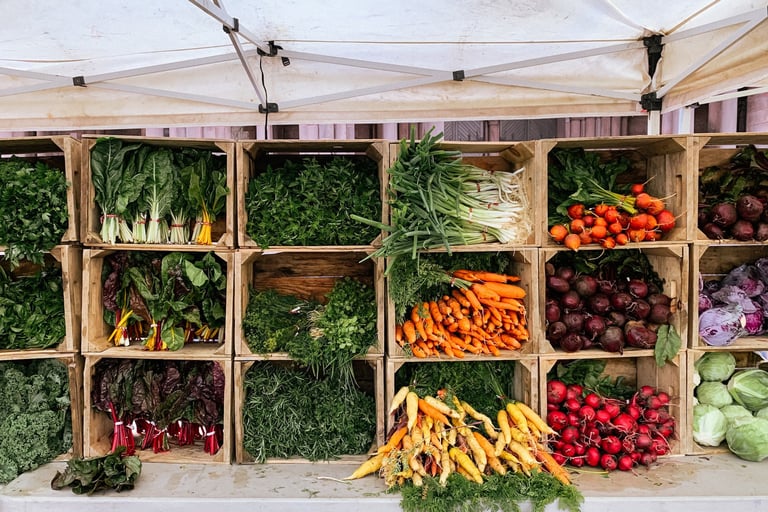What to Buy at the Farmers Market in August
Your go-to guide to the best in-season produce
and how to spot the good stuff.


There’s something deeply comforting about August produce. The colors are deeper, the tomatoes are heavy, and the melons practically perfume the market stalls. These weeks are the last golden moment before fall hits, and they’re packed with fruits and veggies that don’t just feed you, they romance you a little.
Below is a breakdown of what’s worth scooping up at the farmers market this month, from juicy stone fruits to fragrant herbs. I'm including what varieties I love most and how to know, just by looking or holding it, that you’re bringing home something really good.
🍅 Tomatoes
Best Varieties to Look For:
Heirloom (think: pink, purple, yellow, and green with a meaty, sweet texture)
Brandywine (super juicy and soft-skinned)
Roma (dense and great for cooking)
Cherry or Grape (perfectly snackable and candy-sweet)
How I Shop Them:
I look for tomatoes that feel a little heavier than they should for their size and smell almost earthy near the stem. If they give ever-so-slightly when I press them, I know they’re ready. Wrinkly or cracked? That’s a no for me.
🍑 Stone Fruits
Best Varieties to Look For:
Yellow Peaches (classic tangy-sweet)
White Nectarines (floral, less acidic)
Santa Rosa Plums (dark red and incredibly juicy)
Blenheim Apricots (a little tangy, a lot fragrant)
How I Shop Them:
Stone fruits should smell like what they are—like, you should want to eat them immediately. I gently press near the stem for softness. If it’s rock hard, I wait. If it’s already squishy, I skip.
🌽 Corn
Best Varieties to Look For:
Bi-color (my favorite—sweet and tender)
White Sweet Corn (delicate and sugary)
Yellow Corn (a little starchier, still delicious)
How I Shop Them:
I peek just slightly under the husk—kernels should be plump and tightly packed. The outer husk should be bright green and still slightly damp, with golden tassels on top. Bonus: If I press a kernel and it spits, I’m sold.
🫑 Peppers (Sweet & Spicy)
Best Varieties to Look For:
Red & Yellow Bell Peppers (sweeter than green)
Shishito Peppers (mild and perfect for blistering in a pan)
Jalapeños (deep green and curved are usually spicier)
Banana Peppers (tangy and made for pickling)
How I Shop Them:
They should feel firm and look glossy—like they were just picked. I skip anything wrinkled or soft. And if I’m going for heat, a few tiny stretch marks on jalapeños can mean more spice, which is usually aim for.
🍓 Berries
Best Varieties to Look For:
Strawberries (small and deep red = flavor bomb)
Blueberries (a little dusty-looking? That’s the natural bloom)
Blackberries (super plump and shiny)
Raspberries (light, hollow centers mean they’re perfectly ripe)
How I Shop Them:
I avoid any container where the berries are leaking, smashed, or moldy at the bottom. I go for dry, fragrant, firm fruit with no mush. Also, if you’re into snacking as you walk through the market, this is your category.
🍈 Melons
Best Varieties to Look For:
Cantaloupe (fragrant and slightly soft at the stem end)
Watermelon (mini, heirloom, or seedless—there’s no wrong choice)
Honeydew (pale yellow skin and sweet-smelling)
How I Shop Them:
I thump watermelons (yep, really)—they should sound hollow. I also check the field spot (that pale spot on the bottom)—the more yellow it is, the better it ripened. Melons should also feel heavy for their size. Like, surprise-you heavy.
🥬 Lettuce & Tender Greens
Best Varieties to Look For:
Little Gem (crunchy and buttery)
Lollo Rosso (ruffled red leaves with a delicate bite)
Romaine (classic crunch)
Arugula (peppery, bold, a little wild)
How I Shop Them:
I go for bunches that feel fresh and bouncy—not soggy or overly damp. No dark edges or limp leaves. If the heads still have their roots, even better—they’ll last longer in the fridge. I wrap mine in a wet paper towel and place on a plate on inside a bag and I swear it lasts forever.
🌿 Herbs
Best Varieties to Look For:
Basil (Genovese or Purple—both thrive in August)
Mint (Spearmint is my go-to)
Cilantro (bright and leafy, not droopy)
Oregano + Thyme (woody and fragrant)
How I Shop Them:
I love purchasing herbs with roots or sold as living plants so I can replant them at home or in a jar of water to extend their life. This way, next time, I don’t have to buy again or wait for them to grow from seeds!
🥕 Carrots & Root Veg
Best Varieties to Look For:
Rainbow Carrots (deep purple, yellow, and bright orange)
Baby Carrots (the real kind—small, sweet, and fresh-picked)
Beets (Chioggia, golden, red—all peak now)
Radishes (especially Watermelon or French Breakfast types)
How I Shop Them:
Carrots should snap when you bend them—no floppiness everrrrr. I go for smooth roots with vibrant tops (when attached). For beets and radishes, they should feel heavy and look vibrant without too many scratches or dings.
🧅 Onions
Best Varieties to Look For:
Sweet Onions (Vidalia, Walla Walla—for roasting and grilling)
Red Onions (sharp, perfect raw or cooked)
Spring Onions (like scallions with a little more body)
Shallots (delicate and sweet)
How I Shop Them:
Onions should feel dry and papery on the outside, and firm when I give them a squeeze. If I see sprouts or dampness, I pass. For sweeter types, the skin is often thinner, so I handle them gently.
August is a fleeting season, and it’s also one of the most flavorful. Fill your tote, grab a peach for the walk home, and trust your senses. If it smells amazing, it probably is.
🥒 Zucchini & Summer Squash
Best Varieties to Look For:
Green Zucchini (mild, versatile, perfect for sautés and bakes)
Yellow Squash (buttery and tender, great for roasting or raw ribbons)
Pattypan Squash (adorable and nutty, best when halved and grilled)
Costata Romanesco (striped and flavorful—perfect for summer grilling or raw salads)
How I Shop Them:
I go for smaller, slimmer squash—they're usually more tender and less watery. The skin should be glossy and firm with no soft spots or shriveling at the stem. If it feels heavy for its size, that’s a good sign!
